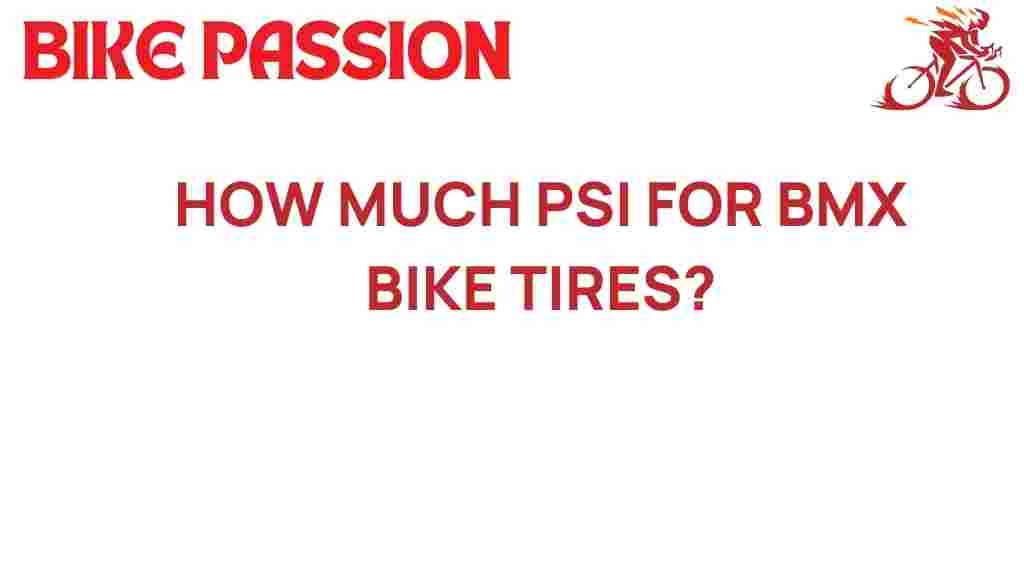Unlocking Performance: The Ideal PSI for BMX Bike Tires
When it comes to BMX biking, the performance of your ride is heavily influenced by the PSI of your BMX bike tires. Understanding the ideal tire pressure can transform your riding experience, enhance safety, and prolong the life of your tires. In this article, we will cover everything you need to know about maintaining the perfect PSI for your BMX bike tires.
Understanding PSI and Its Importance
PSI, or pounds per square inch, is a unit of measurement used to describe the pressure within your bike tires. Proper tire pressure affects various aspects of your biking experience, including:
- Performance: Correct PSI ensures optimal contact with the ground, improving grip and speed.
- Safety: Overinflated or underinflated tires can lead to blowouts or loss of control.
- Maintenance: Keeping your tires at the right pressure reduces wear and tear.
Determining the Ideal PSI for BMX Bike Tires
Finding the right PSI for your BMX bike tires involves considering several factors:
- Rider Weight: Heavier riders may need a higher PSI to prevent pinch flats.
- Riding Style: Street riders may prefer lower pressures for better traction, while racers might opt for higher pressures for speed.
- Terrain: The surface you ride on can significantly influence the ideal PSI. Smooth surfaces allow for higher PSI, while rough terrains may require lower PSI for better shock absorption.
General PSI Guidelines for BMX Bikes
While the perfect PSI can vary, here are some general guidelines to help you set your BMX bike tires:
- For street riding: 30-50 PSI
- For dirt jumping: 25-40 PSI
- For racing: 50-70 PSI
Always refer to the manufacturer’s recommendations found on the tire sidewall for specific pressure guidelines.
How to Inflate Your BMX Bike Tires: Step-by-Step Process
Maintaining the right tire pressure is essential for performance and safety. Here’s a step-by-step guide on how to inflate your BMX bike tires:
Step 1: Gather Your Tools
You will need:
- A reliable pump (preferably with a pressure gauge)
- A tire gauge (if your pump doesn’t have one)
- A valve cap remover (if needed)
Step 2: Check Current Tire Pressure
Before inflating, check the current tire pressure using a gauge. This will help you determine how much air you need to add.
Step 3: Remove the Valve Cap
Unscrew the valve cap from the tire valve. Keep it in a safe place as you will need it later.
Step 4: Attach the Pump
Attach the pump head securely to the valve. Ensure it’s snug to prevent air leakage.
Step 5: Inflate the Tire
Begin pumping until you reach the desired PSI. Make sure to monitor the pressure using the gauge.
Step 6: Recheck Pressure
After inflating, detach the pump and check the pressure again to ensure it is at the correct level.
Step 7: Replace the Valve Cap
Once satisfied with the tire pressure, screw the valve cap back onto the valve to keep dirt and debris out.
Regular Maintenance Tips for BMX Bike Tires
To ensure long-lasting performance from your BMX bike tires, follow these maintenance tips:
- Check Tire Pressure Regularly: Make it a habit to check your PSI before every ride.
- Inspect for Damage: Look for cuts, punctures, or unusual wear that may affect performance.
- Rotate Tires: Regularly rotating your tires can help even out wear and extend their life.
- Store Properly: When not in use, store your bike in a cool, dry place away from direct sunlight.
Troubleshooting Common Tire Issues
Even with regular maintenance, issues can arise. Here are some common problems and troubleshooting tips:
Problem: Flat Tire
Solution: Inspect the tire for punctures or sharp objects. If found, patch the tire or replace it if necessary.
Problem: Uneven Wear
Solution: Check your PSI and ensure it’s consistent with your riding style and weight. Rotate tires to even out wear.
Problem: Excessive Bouncing
Solution: This may indicate your tires are overinflated. Check the PSI and reduce it if necessary.
Problem: Poor Grip
Solution: If you’re experiencing poor grip, consider lowering your PSI slightly, especially for street riding.
Safety Considerations
Maintaining the proper PSI in your BMX bike tires is not just about performance; it’s also about safety. Here are some key safety considerations:
- Blowouts: Overinflated tires are more prone to blowouts, especially during jumps or rough rides.
- Control: Underinflated tires can make your bike harder to control, increasing the risk of accidents.
- Traction: Correct PSI improves traction, which is essential for performing tricks and navigating terrain.
Conclusion
In conclusion, understanding and maintaining the ideal PSI for your BMX bike tires is crucial for enhancing your overall riding experience. Proper tire pressure not only boosts performance but also ensures safety and longevity of your tires. By following the tips provided in this article, you can unlock your bike’s full potential and enjoy every ride to the fullest.
For more information on bike maintenance and performance tips, check out our other articles on BMX bike care. If you’re looking for specific tire options, visit this resource for expert recommendations.
This article is in the category Maintenance and created by BikePassion Team
